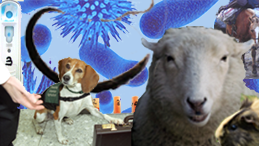
ANSC20003 Topics in Animal Health
Prac 1: Mastitis Diagnostics
Prac 1: Mastitis Diagnostics

Method: catalase
This test determines whether the enzyme catalase is present in the bacteria. Catalase is an enzyme found in many bacteria, causing the breakdown of hydrogen peroxide (H2O2) with the release of free oxygen (O2) – seen as bubbles. It occurs in only some species of bacteria.- It is a good idea to do the catalase test on several bacteria at the one time to compare the results.
- Flame a wire loop to sterilise it then let it cool.
- With a sterile tooth pick scrape a pure bacterial colony from the MAC on a clean glass slide. Plate. If there are no colonies on the MAC plate take one from the AESS plate, but make sure you do not take any agar with it as the blood will cause a catalase reaction. If they are very small colonies you can take a few in the scraping.
- Add one (1) drop of 3% hydrogen peroxide (H2O2) and observe whether bubbles appear. A positive result is when you see vigorous bubbling within 30 seconds. The presence of some small bubbles is not an indication of a positive test.
- Record your observations (Table 1).
Performing the Catalase Reaction Test
Catalase Negative - (left) and Positive + (right) reactions